Cyber Warfare: Technologies, Challenges, and Future Research Analysis
VerifiedAdded on 2023/06/05
|11
|2621
|331
Report
AI Summary
This report provides a comprehensive overview of cyber warfare, beginning with an introduction that emphasizes its significance as a modern form of conflict, akin to traditional warfare. It explores the topic through a literature review, covering relevant technologies such as Cyber Counter-deception and Stuxnet, and their applications in cyber defense. The report highlights the challenges and problems in cyber warfare, including knowledge gaps and the time-consuming nature of developing cyber weapons. It identifies gaps in existing literature, discussing areas that have been addressed and those that require further research. The report also summarizes future research directions based on these identified gaps, advocating for the development of technologies that predict attacker strategies. Furthermore, it offers a critical evaluation of recent research articles, noting both strengths and inconsistencies, before concluding that cyber warfare demands as much preparation as conventional warfare. The report underscores the importance of understanding cyber warfare and its implications, emphasizing the need for continuous research and development in this critical field.
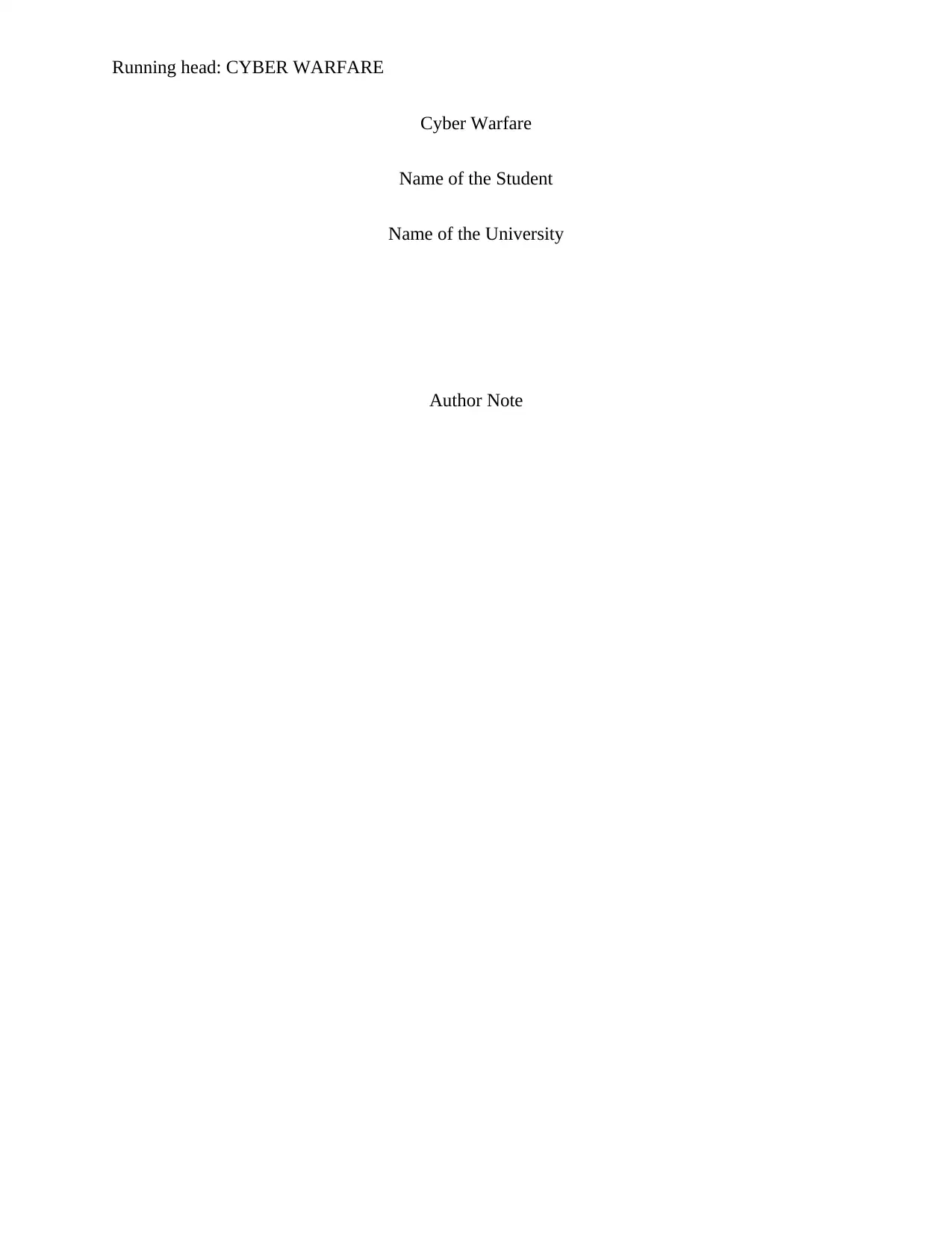
Running head: CYBER WARFARE
Cyber Warfare
Name of the Student
Name of the University
Author Note
Cyber Warfare
Name of the Student
Name of the University
Author Note
Paraphrase This Document
Need a fresh take? Get an instant paraphrase of this document with our AI Paraphraser
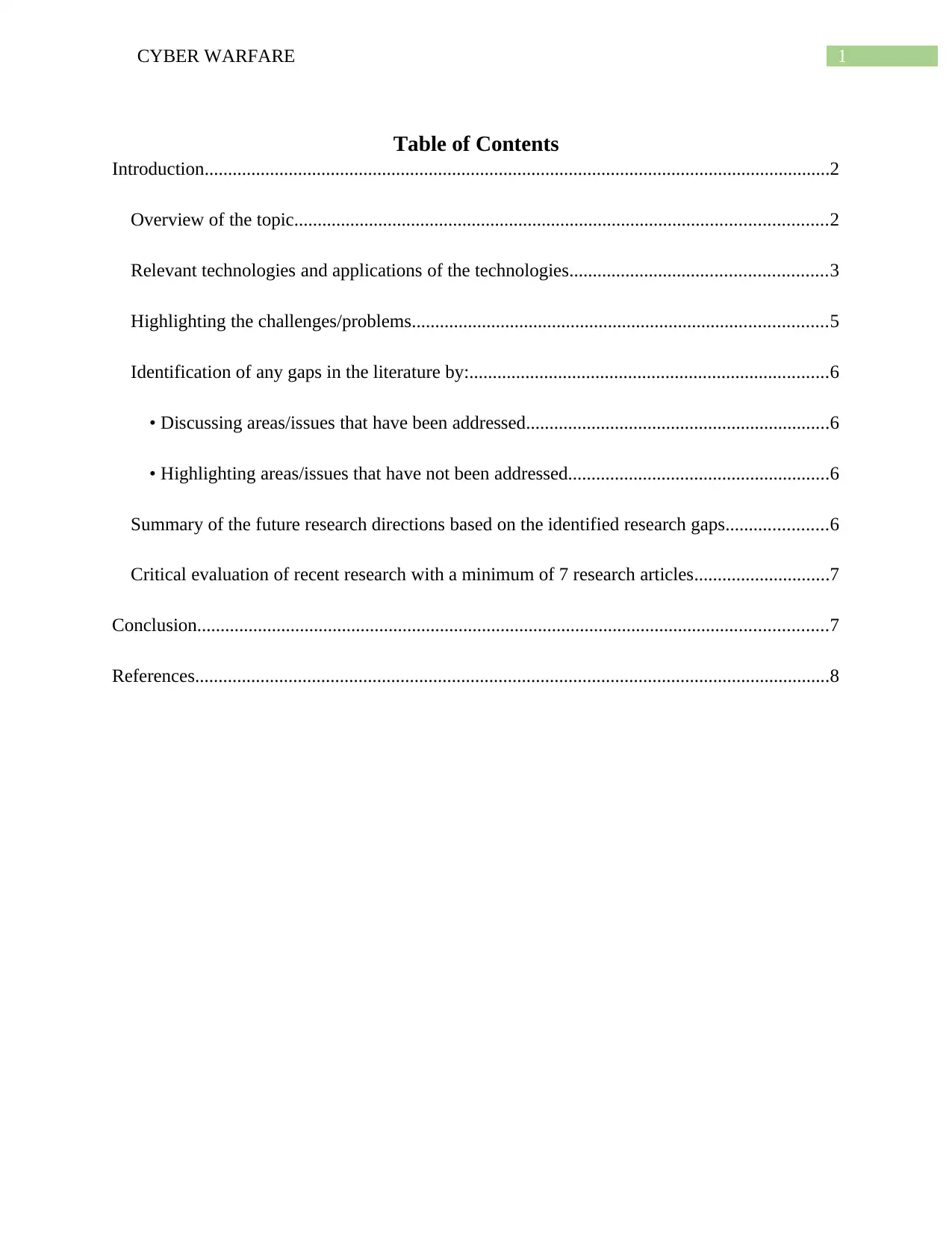
1CYBER WARFARE
Table of Contents
Introduction......................................................................................................................................2
Overview of the topic..................................................................................................................2
Relevant technologies and applications of the technologies.......................................................3
Highlighting the challenges/problems.........................................................................................5
Identification of any gaps in the literature by:.............................................................................6
• Discussing areas/issues that have been addressed.................................................................6
• Highlighting areas/issues that have not been addressed........................................................6
Summary of the future research directions based on the identified research gaps......................6
Critical evaluation of recent research with a minimum of 7 research articles.............................7
Conclusion.......................................................................................................................................7
References........................................................................................................................................8
Table of Contents
Introduction......................................................................................................................................2
Overview of the topic..................................................................................................................2
Relevant technologies and applications of the technologies.......................................................3
Highlighting the challenges/problems.........................................................................................5
Identification of any gaps in the literature by:.............................................................................6
• Discussing areas/issues that have been addressed.................................................................6
• Highlighting areas/issues that have not been addressed........................................................6
Summary of the future research directions based on the identified research gaps......................6
Critical evaluation of recent research with a minimum of 7 research articles.............................7
Conclusion.......................................................................................................................................7
References........................................................................................................................................8
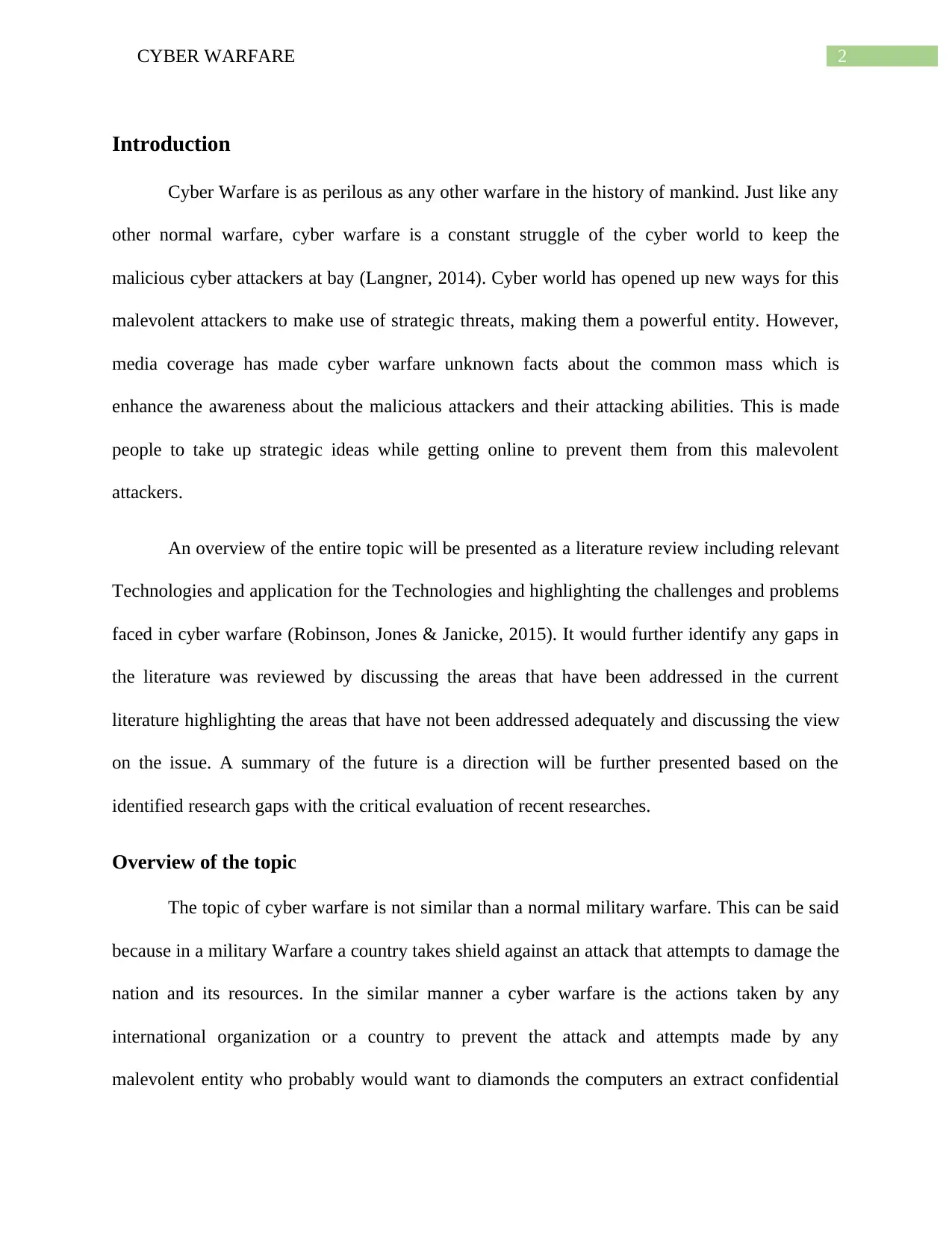
2CYBER WARFARE
Introduction
Cyber Warfare is as perilous as any other warfare in the history of mankind. Just like any
other normal warfare, cyber warfare is a constant struggle of the cyber world to keep the
malicious cyber attackers at bay (Langner, 2014). Cyber world has opened up new ways for this
malevolent attackers to make use of strategic threats, making them a powerful entity. However,
media coverage has made cyber warfare unknown facts about the common mass which is
enhance the awareness about the malicious attackers and their attacking abilities. This is made
people to take up strategic ideas while getting online to prevent them from this malevolent
attackers.
An overview of the entire topic will be presented as a literature review including relevant
Technologies and application for the Technologies and highlighting the challenges and problems
faced in cyber warfare (Robinson, Jones & Janicke, 2015). It would further identify any gaps in
the literature was reviewed by discussing the areas that have been addressed in the current
literature highlighting the areas that have not been addressed adequately and discussing the view
on the issue. A summary of the future is a direction will be further presented based on the
identified research gaps with the critical evaluation of recent researches.
Overview of the topic
The topic of cyber warfare is not similar than a normal military warfare. This can be said
because in a military Warfare a country takes shield against an attack that attempts to damage the
nation and its resources. In the similar manner a cyber warfare is the actions taken by any
international organization or a country to prevent the attack and attempts made by any
malevolent entity who probably would want to diamonds the computers an extract confidential
Introduction
Cyber Warfare is as perilous as any other warfare in the history of mankind. Just like any
other normal warfare, cyber warfare is a constant struggle of the cyber world to keep the
malicious cyber attackers at bay (Langner, 2014). Cyber world has opened up new ways for this
malevolent attackers to make use of strategic threats, making them a powerful entity. However,
media coverage has made cyber warfare unknown facts about the common mass which is
enhance the awareness about the malicious attackers and their attacking abilities. This is made
people to take up strategic ideas while getting online to prevent them from this malevolent
attackers.
An overview of the entire topic will be presented as a literature review including relevant
Technologies and application for the Technologies and highlighting the challenges and problems
faced in cyber warfare (Robinson, Jones & Janicke, 2015). It would further identify any gaps in
the literature was reviewed by discussing the areas that have been addressed in the current
literature highlighting the areas that have not been addressed adequately and discussing the view
on the issue. A summary of the future is a direction will be further presented based on the
identified research gaps with the critical evaluation of recent researches.
Overview of the topic
The topic of cyber warfare is not similar than a normal military warfare. This can be said
because in a military Warfare a country takes shield against an attack that attempts to damage the
nation and its resources. In the similar manner a cyber warfare is the actions taken by any
international organization or a country to prevent the attack and attempts made by any
malevolent entity who probably would want to diamonds the computers an extract confidential
⊘ This is a preview!⊘
Do you want full access?
Subscribe today to unlock all pages.

Trusted by 1+ million students worldwide
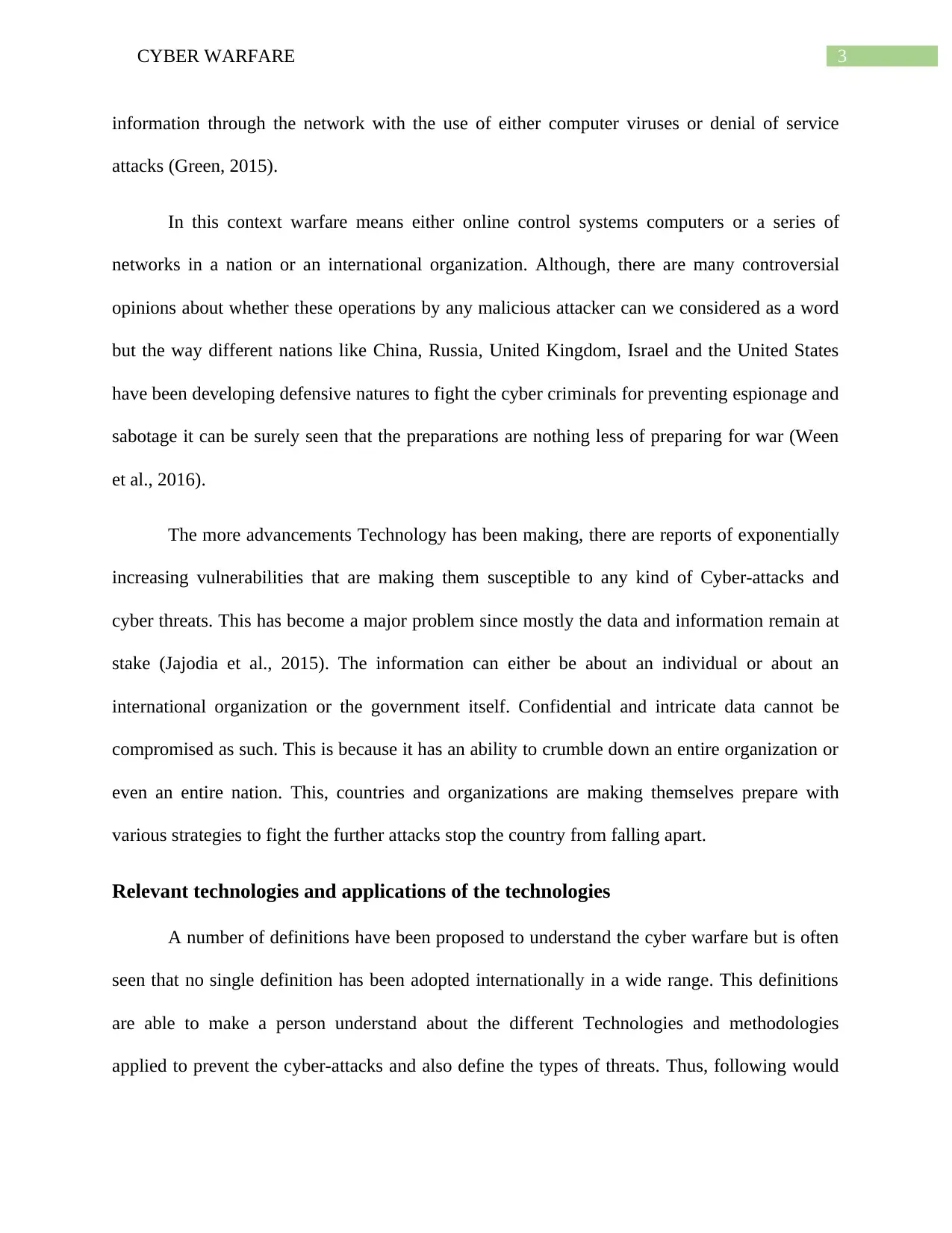
3CYBER WARFARE
information through the network with the use of either computer viruses or denial of service
attacks (Green, 2015).
In this context warfare means either online control systems computers or a series of
networks in a nation or an international organization. Although, there are many controversial
opinions about whether these operations by any malicious attacker can we considered as a word
but the way different nations like China, Russia, United Kingdom, Israel and the United States
have been developing defensive natures to fight the cyber criminals for preventing espionage and
sabotage it can be surely seen that the preparations are nothing less of preparing for war (Ween
et al., 2016).
The more advancements Technology has been making, there are reports of exponentially
increasing vulnerabilities that are making them susceptible to any kind of Cyber-attacks and
cyber threats. This has become a major problem since mostly the data and information remain at
stake (Jajodia et al., 2015). The information can either be about an individual or about an
international organization or the government itself. Confidential and intricate data cannot be
compromised as such. This is because it has an ability to crumble down an entire organization or
even an entire nation. This, countries and organizations are making themselves prepare with
various strategies to fight the further attacks stop the country from falling apart.
Relevant technologies and applications of the technologies
A number of definitions have been proposed to understand the cyber warfare but is often
seen that no single definition has been adopted internationally in a wide range. This definitions
are able to make a person understand about the different Technologies and methodologies
applied to prevent the cyber-attacks and also define the types of threats. Thus, following would
information through the network with the use of either computer viruses or denial of service
attacks (Green, 2015).
In this context warfare means either online control systems computers or a series of
networks in a nation or an international organization. Although, there are many controversial
opinions about whether these operations by any malicious attacker can we considered as a word
but the way different nations like China, Russia, United Kingdom, Israel and the United States
have been developing defensive natures to fight the cyber criminals for preventing espionage and
sabotage it can be surely seen that the preparations are nothing less of preparing for war (Ween
et al., 2016).
The more advancements Technology has been making, there are reports of exponentially
increasing vulnerabilities that are making them susceptible to any kind of Cyber-attacks and
cyber threats. This has become a major problem since mostly the data and information remain at
stake (Jajodia et al., 2015). The information can either be about an individual or about an
international organization or the government itself. Confidential and intricate data cannot be
compromised as such. This is because it has an ability to crumble down an entire organization or
even an entire nation. This, countries and organizations are making themselves prepare with
various strategies to fight the further attacks stop the country from falling apart.
Relevant technologies and applications of the technologies
A number of definitions have been proposed to understand the cyber warfare but is often
seen that no single definition has been adopted internationally in a wide range. This definitions
are able to make a person understand about the different Technologies and methodologies
applied to prevent the cyber-attacks and also define the types of threats. Thus, following would
Paraphrase This Document
Need a fresh take? Get an instant paraphrase of this document with our AI Paraphraser
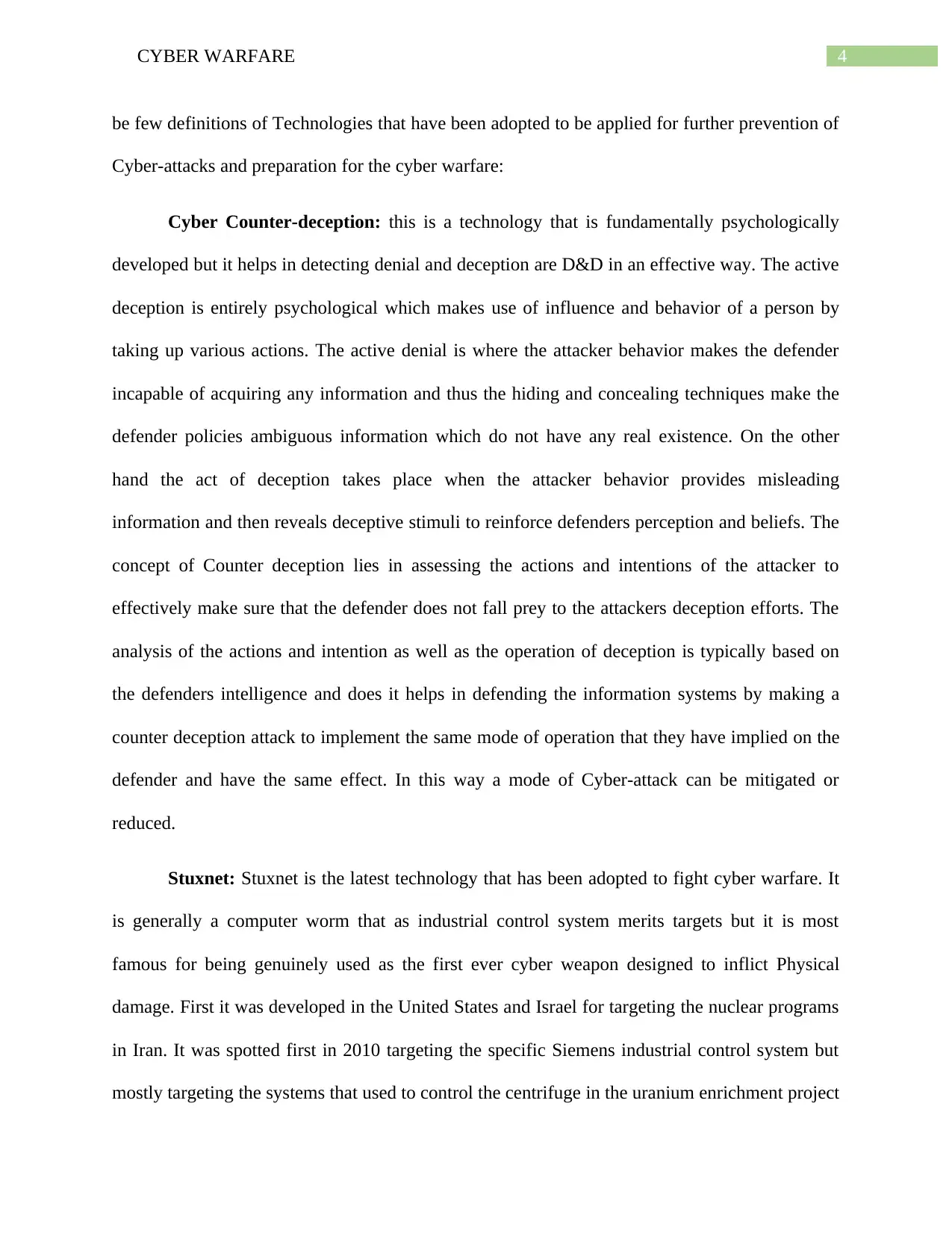
4CYBER WARFARE
be few definitions of Technologies that have been adopted to be applied for further prevention of
Cyber-attacks and preparation for the cyber warfare:
Cyber Counter-deception: this is a technology that is fundamentally psychologically
developed but it helps in detecting denial and deception are D&D in an effective way. The active
deception is entirely psychological which makes use of influence and behavior of a person by
taking up various actions. The active denial is where the attacker behavior makes the defender
incapable of acquiring any information and thus the hiding and concealing techniques make the
defender policies ambiguous information which do not have any real existence. On the other
hand the act of deception takes place when the attacker behavior provides misleading
information and then reveals deceptive stimuli to reinforce defenders perception and beliefs. The
concept of Counter deception lies in assessing the actions and intentions of the attacker to
effectively make sure that the defender does not fall prey to the attackers deception efforts. The
analysis of the actions and intention as well as the operation of deception is typically based on
the defenders intelligence and does it helps in defending the information systems by making a
counter deception attack to implement the same mode of operation that they have implied on the
defender and have the same effect. In this way a mode of Cyber-attack can be mitigated or
reduced.
Stuxnet: Stuxnet is the latest technology that has been adopted to fight cyber warfare. It
is generally a computer worm that as industrial control system merits targets but it is most
famous for being genuinely used as the first ever cyber weapon designed to inflict Physical
damage. First it was developed in the United States and Israel for targeting the nuclear programs
in Iran. It was spotted first in 2010 targeting the specific Siemens industrial control system but
mostly targeting the systems that used to control the centrifuge in the uranium enrichment project
be few definitions of Technologies that have been adopted to be applied for further prevention of
Cyber-attacks and preparation for the cyber warfare:
Cyber Counter-deception: this is a technology that is fundamentally psychologically
developed but it helps in detecting denial and deception are D&D in an effective way. The active
deception is entirely psychological which makes use of influence and behavior of a person by
taking up various actions. The active denial is where the attacker behavior makes the defender
incapable of acquiring any information and thus the hiding and concealing techniques make the
defender policies ambiguous information which do not have any real existence. On the other
hand the act of deception takes place when the attacker behavior provides misleading
information and then reveals deceptive stimuli to reinforce defenders perception and beliefs. The
concept of Counter deception lies in assessing the actions and intentions of the attacker to
effectively make sure that the defender does not fall prey to the attackers deception efforts. The
analysis of the actions and intention as well as the operation of deception is typically based on
the defenders intelligence and does it helps in defending the information systems by making a
counter deception attack to implement the same mode of operation that they have implied on the
defender and have the same effect. In this way a mode of Cyber-attack can be mitigated or
reduced.
Stuxnet: Stuxnet is the latest technology that has been adopted to fight cyber warfare. It
is generally a computer worm that as industrial control system merits targets but it is most
famous for being genuinely used as the first ever cyber weapon designed to inflict Physical
damage. First it was developed in the United States and Israel for targeting the nuclear programs
in Iran. It was spotted first in 2010 targeting the specific Siemens industrial control system but
mostly targeting the systems that used to control the centrifuge in the uranium enrichment project
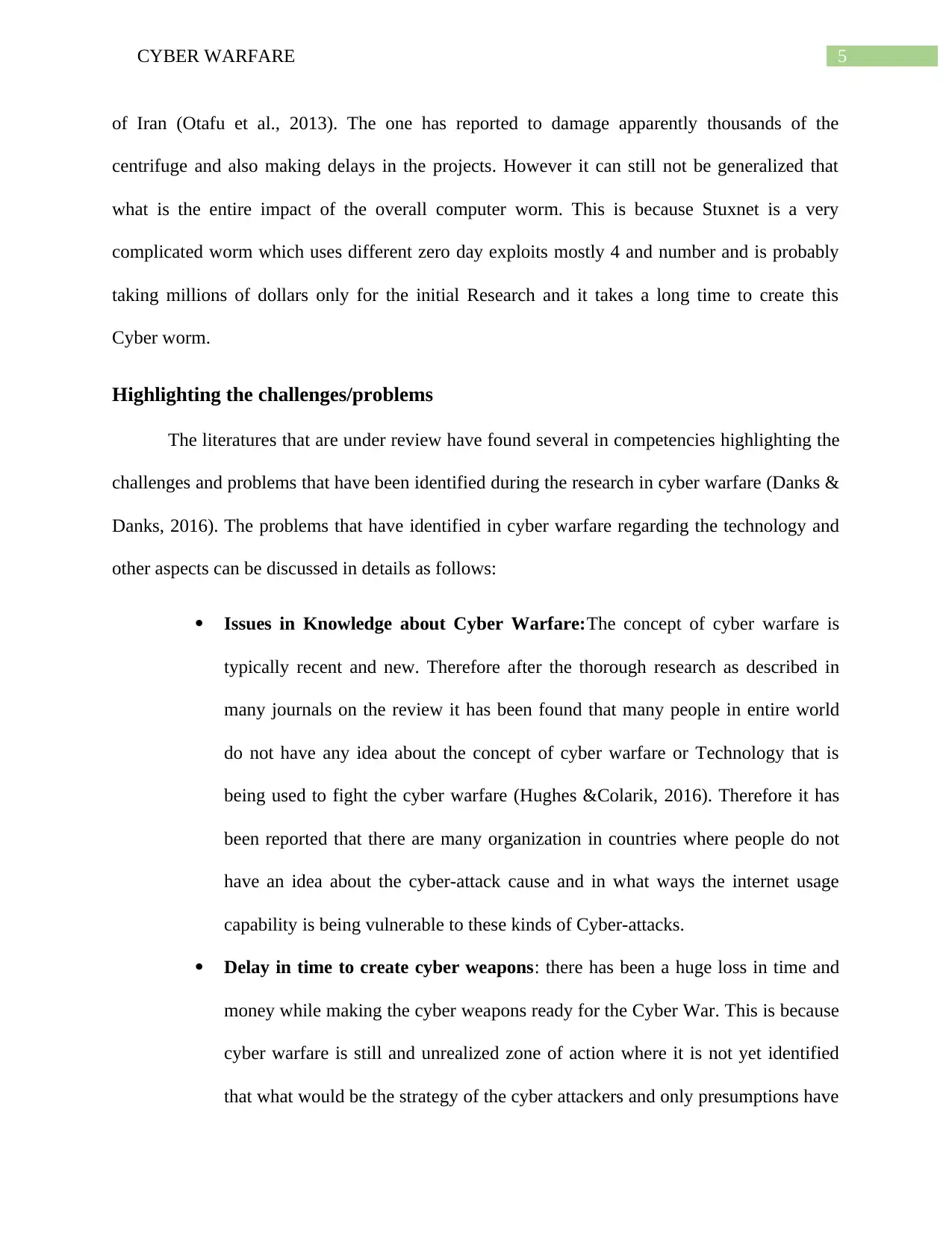
5CYBER WARFARE
of Iran (Otafu et al., 2013). The one has reported to damage apparently thousands of the
centrifuge and also making delays in the projects. However it can still not be generalized that
what is the entire impact of the overall computer worm. This is because Stuxnet is a very
complicated worm which uses different zero day exploits mostly 4 and number and is probably
taking millions of dollars only for the initial Research and it takes a long time to create this
Cyber worm.
Highlighting the challenges/problems
The literatures that are under review have found several in competencies highlighting the
challenges and problems that have been identified during the research in cyber warfare (Danks &
Danks, 2016). The problems that have identified in cyber warfare regarding the technology and
other aspects can be discussed in details as follows:
Issues in Knowledge about Cyber Warfare:The concept of cyber warfare is
typically recent and new. Therefore after the thorough research as described in
many journals on the review it has been found that many people in entire world
do not have any idea about the concept of cyber warfare or Technology that is
being used to fight the cyber warfare (Hughes &Colarik, 2016). Therefore it has
been reported that there are many organization in countries where people do not
have an idea about the cyber-attack cause and in what ways the internet usage
capability is being vulnerable to these kinds of Cyber-attacks.
Delay in time to create cyber weapons: there has been a huge loss in time and
money while making the cyber weapons ready for the Cyber War. This is because
cyber warfare is still and unrealized zone of action where it is not yet identified
that what would be the strategy of the cyber attackers and only presumptions have
of Iran (Otafu et al., 2013). The one has reported to damage apparently thousands of the
centrifuge and also making delays in the projects. However it can still not be generalized that
what is the entire impact of the overall computer worm. This is because Stuxnet is a very
complicated worm which uses different zero day exploits mostly 4 and number and is probably
taking millions of dollars only for the initial Research and it takes a long time to create this
Cyber worm.
Highlighting the challenges/problems
The literatures that are under review have found several in competencies highlighting the
challenges and problems that have been identified during the research in cyber warfare (Danks &
Danks, 2016). The problems that have identified in cyber warfare regarding the technology and
other aspects can be discussed in details as follows:
Issues in Knowledge about Cyber Warfare:The concept of cyber warfare is
typically recent and new. Therefore after the thorough research as described in
many journals on the review it has been found that many people in entire world
do not have any idea about the concept of cyber warfare or Technology that is
being used to fight the cyber warfare (Hughes &Colarik, 2016). Therefore it has
been reported that there are many organization in countries where people do not
have an idea about the cyber-attack cause and in what ways the internet usage
capability is being vulnerable to these kinds of Cyber-attacks.
Delay in time to create cyber weapons: there has been a huge loss in time and
money while making the cyber weapons ready for the Cyber War. This is because
cyber warfare is still and unrealized zone of action where it is not yet identified
that what would be the strategy of the cyber attackers and only presumptions have
⊘ This is a preview!⊘
Do you want full access?
Subscribe today to unlock all pages.

Trusted by 1+ million students worldwide
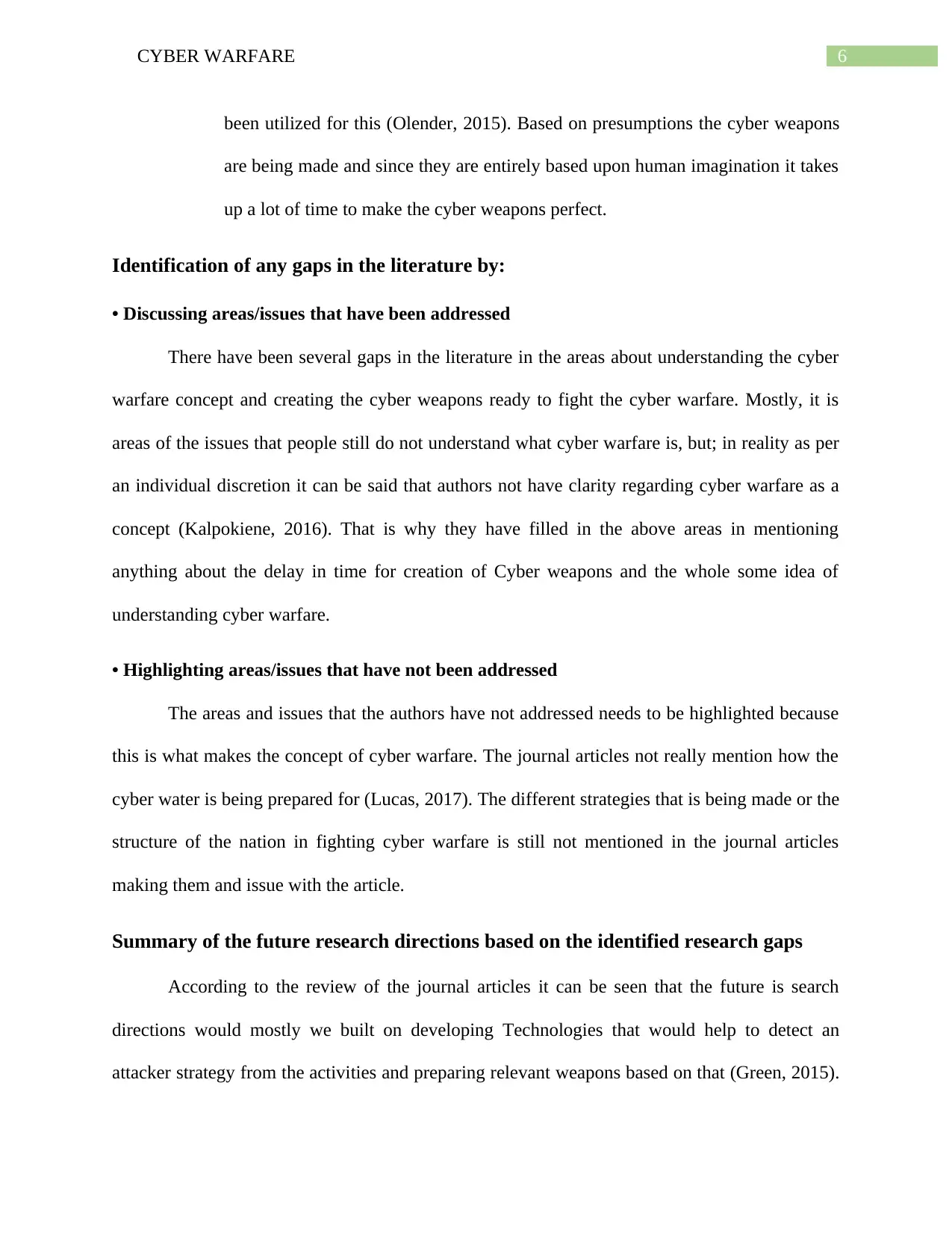
6CYBER WARFARE
been utilized for this (Olender, 2015). Based on presumptions the cyber weapons
are being made and since they are entirely based upon human imagination it takes
up a lot of time to make the cyber weapons perfect.
Identification of any gaps in the literature by:
• Discussing areas/issues that have been addressed
There have been several gaps in the literature in the areas about understanding the cyber
warfare concept and creating the cyber weapons ready to fight the cyber warfare. Mostly, it is
areas of the issues that people still do not understand what cyber warfare is, but; in reality as per
an individual discretion it can be said that authors not have clarity regarding cyber warfare as a
concept (Kalpokiene, 2016). That is why they have filled in the above areas in mentioning
anything about the delay in time for creation of Cyber weapons and the whole some idea of
understanding cyber warfare.
• Highlighting areas/issues that have not been addressed
The areas and issues that the authors have not addressed needs to be highlighted because
this is what makes the concept of cyber warfare. The journal articles not really mention how the
cyber water is being prepared for (Lucas, 2017). The different strategies that is being made or the
structure of the nation in fighting cyber warfare is still not mentioned in the journal articles
making them and issue with the article.
Summary of the future research directions based on the identified research gaps
According to the review of the journal articles it can be seen that the future is search
directions would mostly we built on developing Technologies that would help to detect an
attacker strategy from the activities and preparing relevant weapons based on that (Green, 2015).
been utilized for this (Olender, 2015). Based on presumptions the cyber weapons
are being made and since they are entirely based upon human imagination it takes
up a lot of time to make the cyber weapons perfect.
Identification of any gaps in the literature by:
• Discussing areas/issues that have been addressed
There have been several gaps in the literature in the areas about understanding the cyber
warfare concept and creating the cyber weapons ready to fight the cyber warfare. Mostly, it is
areas of the issues that people still do not understand what cyber warfare is, but; in reality as per
an individual discretion it can be said that authors not have clarity regarding cyber warfare as a
concept (Kalpokiene, 2016). That is why they have filled in the above areas in mentioning
anything about the delay in time for creation of Cyber weapons and the whole some idea of
understanding cyber warfare.
• Highlighting areas/issues that have not been addressed
The areas and issues that the authors have not addressed needs to be highlighted because
this is what makes the concept of cyber warfare. The journal articles not really mention how the
cyber water is being prepared for (Lucas, 2017). The different strategies that is being made or the
structure of the nation in fighting cyber warfare is still not mentioned in the journal articles
making them and issue with the article.
Summary of the future research directions based on the identified research gaps
According to the review of the journal articles it can be seen that the future is search
directions would mostly we built on developing Technologies that would help to detect an
attacker strategy from the activities and preparing relevant weapons based on that (Green, 2015).
Paraphrase This Document
Need a fresh take? Get an instant paraphrase of this document with our AI Paraphraser
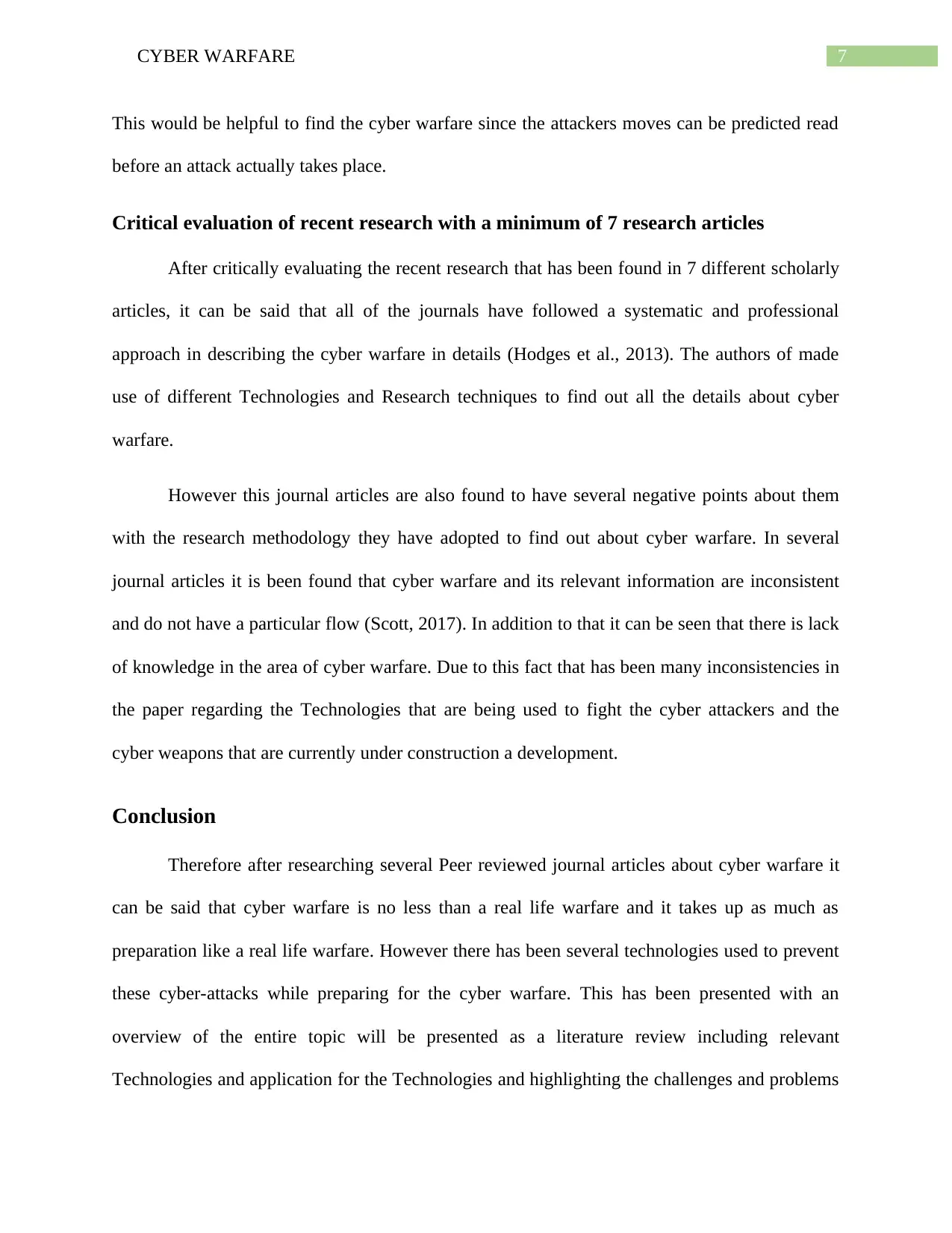
7CYBER WARFARE
This would be helpful to find the cyber warfare since the attackers moves can be predicted read
before an attack actually takes place.
Critical evaluation of recent research with a minimum of 7 research articles
After critically evaluating the recent research that has been found in 7 different scholarly
articles, it can be said that all of the journals have followed a systematic and professional
approach in describing the cyber warfare in details (Hodges et al., 2013). The authors of made
use of different Technologies and Research techniques to find out all the details about cyber
warfare.
However this journal articles are also found to have several negative points about them
with the research methodology they have adopted to find out about cyber warfare. In several
journal articles it is been found that cyber warfare and its relevant information are inconsistent
and do not have a particular flow (Scott, 2017). In addition to that it can be seen that there is lack
of knowledge in the area of cyber warfare. Due to this fact that has been many inconsistencies in
the paper regarding the Technologies that are being used to fight the cyber attackers and the
cyber weapons that are currently under construction a development.
Conclusion
Therefore after researching several Peer reviewed journal articles about cyber warfare it
can be said that cyber warfare is no less than a real life warfare and it takes up as much as
preparation like a real life warfare. However there has been several technologies used to prevent
these cyber-attacks while preparing for the cyber warfare. This has been presented with an
overview of the entire topic will be presented as a literature review including relevant
Technologies and application for the Technologies and highlighting the challenges and problems
This would be helpful to find the cyber warfare since the attackers moves can be predicted read
before an attack actually takes place.
Critical evaluation of recent research with a minimum of 7 research articles
After critically evaluating the recent research that has been found in 7 different scholarly
articles, it can be said that all of the journals have followed a systematic and professional
approach in describing the cyber warfare in details (Hodges et al., 2013). The authors of made
use of different Technologies and Research techniques to find out all the details about cyber
warfare.
However this journal articles are also found to have several negative points about them
with the research methodology they have adopted to find out about cyber warfare. In several
journal articles it is been found that cyber warfare and its relevant information are inconsistent
and do not have a particular flow (Scott, 2017). In addition to that it can be seen that there is lack
of knowledge in the area of cyber warfare. Due to this fact that has been many inconsistencies in
the paper regarding the Technologies that are being used to fight the cyber attackers and the
cyber weapons that are currently under construction a development.
Conclusion
Therefore after researching several Peer reviewed journal articles about cyber warfare it
can be said that cyber warfare is no less than a real life warfare and it takes up as much as
preparation like a real life warfare. However there has been several technologies used to prevent
these cyber-attacks while preparing for the cyber warfare. This has been presented with an
overview of the entire topic will be presented as a literature review including relevant
Technologies and application for the Technologies and highlighting the challenges and problems
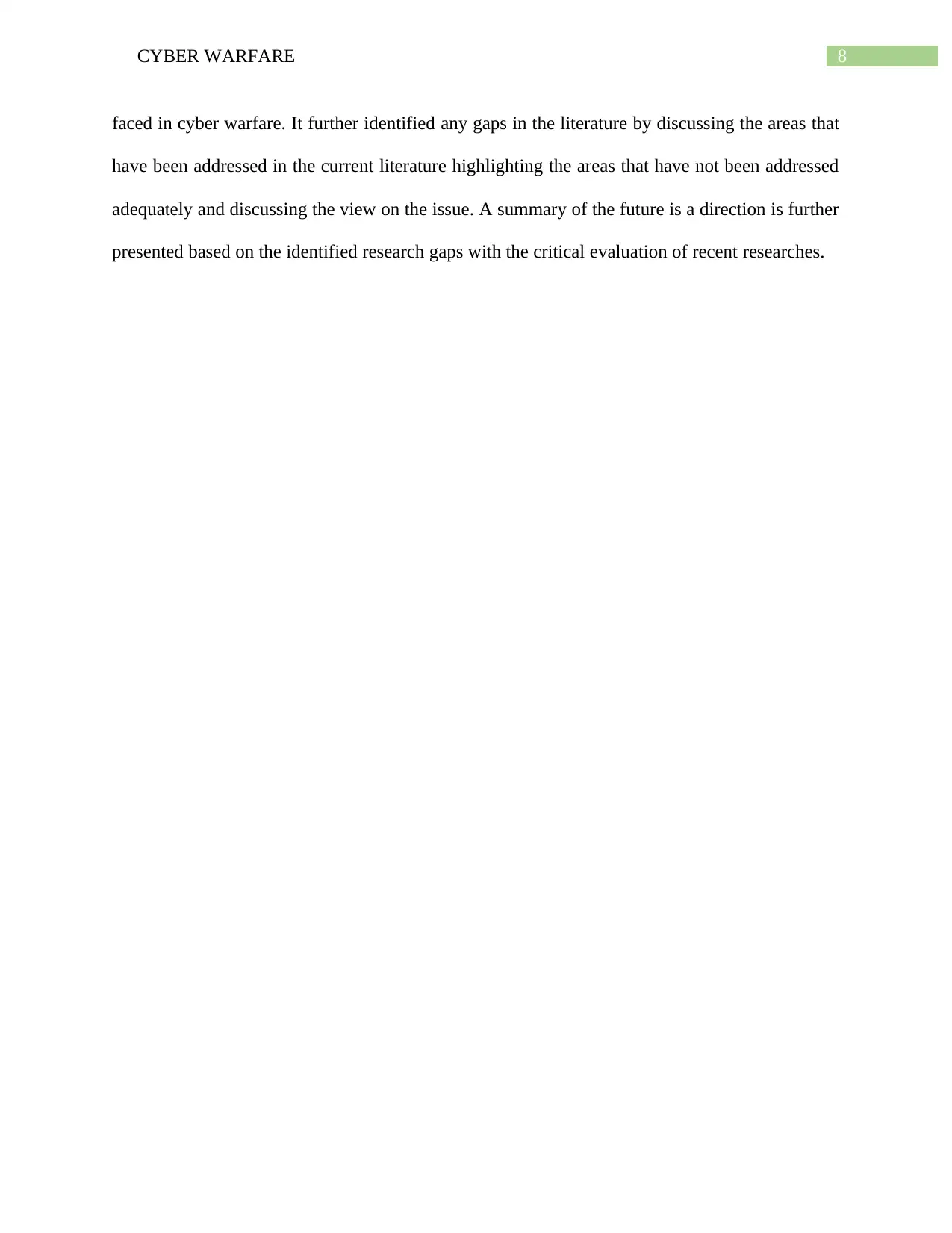
8CYBER WARFARE
faced in cyber warfare. It further identified any gaps in the literature by discussing the areas that
have been addressed in the current literature highlighting the areas that have not been addressed
adequately and discussing the view on the issue. A summary of the future is a direction is further
presented based on the identified research gaps with the critical evaluation of recent researches.
faced in cyber warfare. It further identified any gaps in the literature by discussing the areas that
have been addressed in the current literature highlighting the areas that have not been addressed
adequately and discussing the view on the issue. A summary of the future is a direction is further
presented based on the identified research gaps with the critical evaluation of recent researches.
⊘ This is a preview!⊘
Do you want full access?
Subscribe today to unlock all pages.

Trusted by 1+ million students worldwide
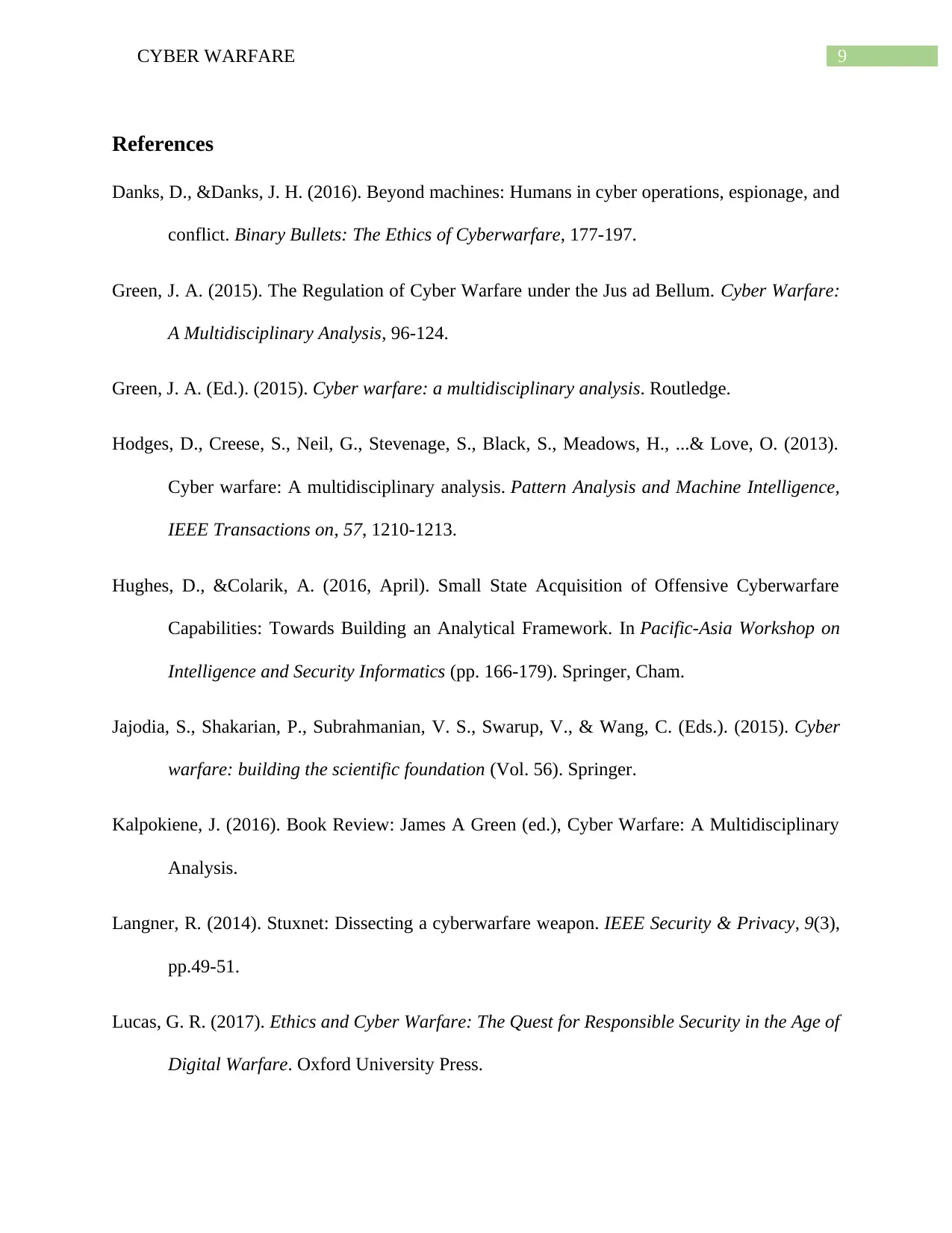
9CYBER WARFARE
References
Danks, D., &Danks, J. H. (2016). Beyond machines: Humans in cyber operations, espionage, and
conflict. Binary Bullets: The Ethics of Cyberwarfare, 177-197.
Green, J. A. (2015). The Regulation of Cyber Warfare under the Jus ad Bellum. Cyber Warfare:
A Multidisciplinary Analysis, 96-124.
Green, J. A. (Ed.). (2015). Cyber warfare: a multidisciplinary analysis. Routledge.
Hodges, D., Creese, S., Neil, G., Stevenage, S., Black, S., Meadows, H., ...& Love, O. (2013).
Cyber warfare: A multidisciplinary analysis. Pattern Analysis and Machine Intelligence,
IEEE Transactions on, 57, 1210-1213.
Hughes, D., &Colarik, A. (2016, April). Small State Acquisition of Offensive Cyberwarfare
Capabilities: Towards Building an Analytical Framework. In Pacific-Asia Workshop on
Intelligence and Security Informatics (pp. 166-179). Springer, Cham.
Jajodia, S., Shakarian, P., Subrahmanian, V. S., Swarup, V., & Wang, C. (Eds.). (2015). Cyber
warfare: building the scientific foundation (Vol. 56). Springer.
Kalpokiene, J. (2016). Book Review: James A Green (ed.), Cyber Warfare: A Multidisciplinary
Analysis.
Langner, R. (2014). Stuxnet: Dissecting a cyberwarfare weapon. IEEE Security & Privacy, 9(3),
pp.49-51.
Lucas, G. R. (2017). Ethics and Cyber Warfare: The Quest for Responsible Security in the Age of
Digital Warfare. Oxford University Press.
References
Danks, D., &Danks, J. H. (2016). Beyond machines: Humans in cyber operations, espionage, and
conflict. Binary Bullets: The Ethics of Cyberwarfare, 177-197.
Green, J. A. (2015). The Regulation of Cyber Warfare under the Jus ad Bellum. Cyber Warfare:
A Multidisciplinary Analysis, 96-124.
Green, J. A. (Ed.). (2015). Cyber warfare: a multidisciplinary analysis. Routledge.
Hodges, D., Creese, S., Neil, G., Stevenage, S., Black, S., Meadows, H., ...& Love, O. (2013).
Cyber warfare: A multidisciplinary analysis. Pattern Analysis and Machine Intelligence,
IEEE Transactions on, 57, 1210-1213.
Hughes, D., &Colarik, A. (2016, April). Small State Acquisition of Offensive Cyberwarfare
Capabilities: Towards Building an Analytical Framework. In Pacific-Asia Workshop on
Intelligence and Security Informatics (pp. 166-179). Springer, Cham.
Jajodia, S., Shakarian, P., Subrahmanian, V. S., Swarup, V., & Wang, C. (Eds.). (2015). Cyber
warfare: building the scientific foundation (Vol. 56). Springer.
Kalpokiene, J. (2016). Book Review: James A Green (ed.), Cyber Warfare: A Multidisciplinary
Analysis.
Langner, R. (2014). Stuxnet: Dissecting a cyberwarfare weapon. IEEE Security & Privacy, 9(3),
pp.49-51.
Lucas, G. R. (2017). Ethics and Cyber Warfare: The Quest for Responsible Security in the Age of
Digital Warfare. Oxford University Press.
Paraphrase This Document
Need a fresh take? Get an instant paraphrase of this document with our AI Paraphraser
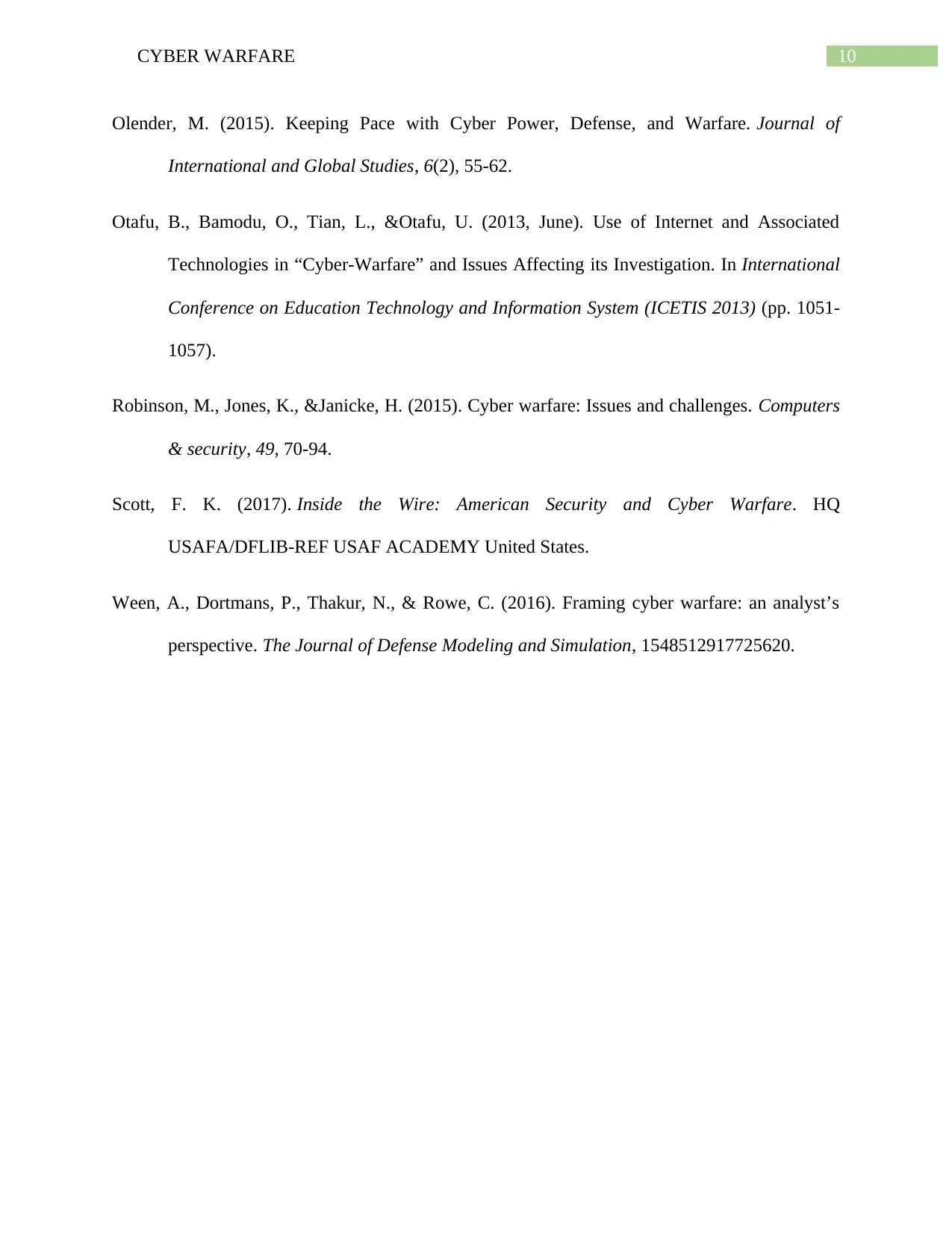
10CYBER WARFARE
Olender, M. (2015). Keeping Pace with Cyber Power, Defense, and Warfare. Journal of
International and Global Studies, 6(2), 55-62.
Otafu, B., Bamodu, O., Tian, L., &Otafu, U. (2013, June). Use of Internet and Associated
Technologies in “Cyber-Warfare” and Issues Affecting its Investigation. In International
Conference on Education Technology and Information System (ICETIS 2013) (pp. 1051-
1057).
Robinson, M., Jones, K., &Janicke, H. (2015). Cyber warfare: Issues and challenges. Computers
& security, 49, 70-94.
Scott, F. K. (2017). Inside the Wire: American Security and Cyber Warfare. HQ
USAFA/DFLIB-REF USAF ACADEMY United States.
Ween, A., Dortmans, P., Thakur, N., & Rowe, C. (2016). Framing cyber warfare: an analyst’s
perspective. The Journal of Defense Modeling and Simulation, 1548512917725620.
Olender, M. (2015). Keeping Pace with Cyber Power, Defense, and Warfare. Journal of
International and Global Studies, 6(2), 55-62.
Otafu, B., Bamodu, O., Tian, L., &Otafu, U. (2013, June). Use of Internet and Associated
Technologies in “Cyber-Warfare” and Issues Affecting its Investigation. In International
Conference on Education Technology and Information System (ICETIS 2013) (pp. 1051-
1057).
Robinson, M., Jones, K., &Janicke, H. (2015). Cyber warfare: Issues and challenges. Computers
& security, 49, 70-94.
Scott, F. K. (2017). Inside the Wire: American Security and Cyber Warfare. HQ
USAFA/DFLIB-REF USAF ACADEMY United States.
Ween, A., Dortmans, P., Thakur, N., & Rowe, C. (2016). Framing cyber warfare: an analyst’s
perspective. The Journal of Defense Modeling and Simulation, 1548512917725620.
1 out of 11
Related Documents
Your All-in-One AI-Powered Toolkit for Academic Success.
+13062052269
info@desklib.com
Available 24*7 on WhatsApp / Email
![[object Object]](/_next/static/media/star-bottom.7253800d.svg)
Unlock your academic potential
Copyright © 2020–2025 A2Z Services. All Rights Reserved. Developed and managed by ZUCOL.





